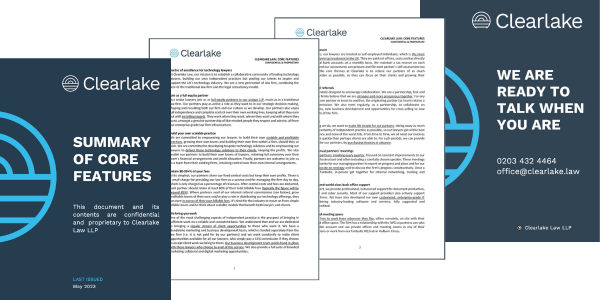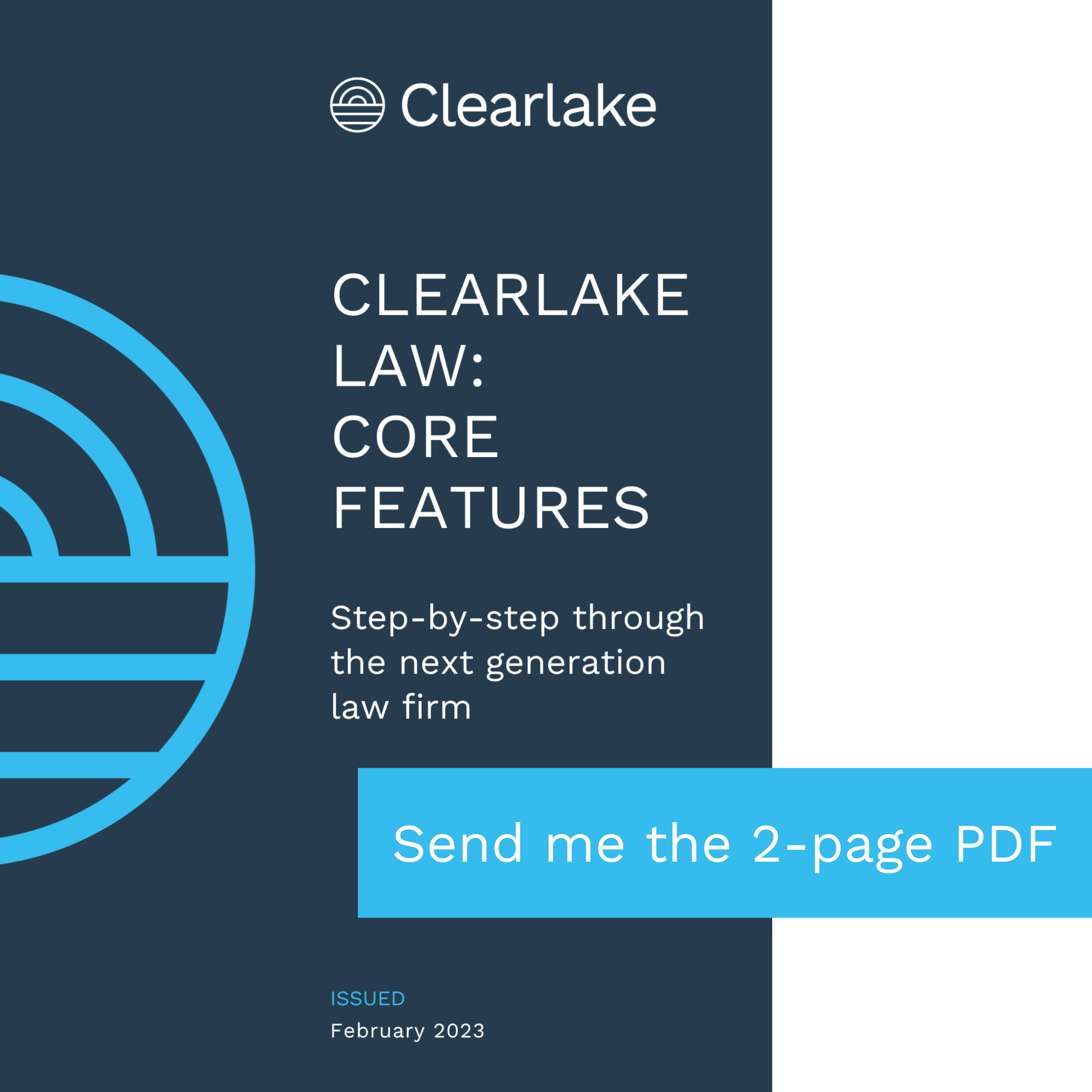The 3 dramatic developments every consultant lawyer must prepare for
There is a widely held view that the existing consultancy model for entrepreneurial lawyers is starting to creak.
Firstly, lawyers working in the consultancy model are likely to start paying between £7,500 and £25,000 more per year in taxes over the coming few years as a result of changes to corporation tax and dividend tax.
Secondly, consultant lawyers (and some of the consultancy platforms) are facing increasingly high risks of unpaid employment taxes and NICs, plus penalties, under the updated IR35 regime.
Despite the consultancy model only being built up over the last two decades, and despite it being intended for the world of modern work, recent developments have put its future in doubt.
On top of these dramatic developments, the fees charged by many of the incumbent platforms are out of date and the reliance on personal services companies (“PSCs”) makes less and less sense in the contemporary working environment.
Lawyers’ lives can and should be extraordinary and fulfilling, particularly for the more enterprising amongst us. Indeed the consultancy model was developed primarily to support lawyers seeking a better life.
That was and still is a laudable endeavour, a critical endeavour for our industry in fact, but the model is in desperate need of a rethink.
Development #1: Increasing corporation tax burden
Corporation tax will rise to 25% from 1 April 2023 for all companies (including PSCs) with profits above £250,000.
Companies with profits below £50,000 will continue to pay corporation tax at 19% with a taper from 19% up to 25% to apply on profits between £50,000 and £250,000.
Assuming a profit of £150,000 for a typical business lawyer’s PSC, an additional corporation tax payment of around 3% (assuming a straight line taper on turnovers between £50,000 and £250,000) is likely, which would mean an additional £4,500 in corporation tax.
For a PSC with profits of £250,000, the additional corporation tax will be £15,000 (a 6% hike).
Development #2: Increasing dividend tax burden
First a PSC pays corporation tax on its profits, then the shareholder pays dividend tax on the remainder when a distribution is made by the PSC.
Dividend tax rates have also been subject to an increase of 1.25%, with dividends falling in the income band from £50,000 to £125,000 being taxed at 33.75% and dividends falling in the income band over £125,000 taxed at 39.35%. Moreover, the annual dividend allowance will decrease from £2,000 to £500.
So assuming our first example of a £150,000 PSC profit, that means about an additional £4,000 in dividend tax for the PSC’s shareholder(s).
For the £250,000 profit PSC, it would mean an additional £5,200 (roughly).
In total then, for PSCs turning over around £175k, paying £12,500 in PAYE and covering their operating costs (i.e. leaving a company profit of around £150k), the shareholders can expect to pay approximately an additional £8,500 in corporation tax and dividend tax.
For a profit of £250,000, the additional tax deduction is likely to be around £20,200 per year – money that could otherwise have been grossed up for SIPP contributions or put towards school fees.
For higher earners, the new tax burden is significantly heavier still.
Development #3: Increasing IR35 risk
Implemented on 6 April 2021, the new private-sector IR35 reforms threw the cat amongst the pigeons for traditional contractor and consultancy models, with organisations up and down the country scrambling to get on the right side of the regulations.
The reforms, and HMRC’s renewed vigour in enforcing them, impose existential threats to many of the consultancy platforms and forced the traditional freelancer/contractor agencies to reconsider their models, offering dual track “inside” and “outside” IR35 assignments, doing their best to judge the difference.
The IR35 rules, also known as the off-payroll working rules, apply most obviously where a worker (lawyer) provides services through their own PSC to a client. In most cases for the legal consultancy model, the relevant “client” is the legal consultancy platform, which then sells that worker’s services on to its own end client.
The rules make sure that workers, who should really be considered employees given their working arrangements, pay broadly the same income tax and national insurance contributions as employees.
The largest and most obvious difference between tax paid by an employee and tax paid using a PSC is typically the lack of Employers’ NICs (now chargeable at just over 15%), which is not payable where a PSC is used “outside” IR35 (i.e. in a genuine arm’s length situation).
Having said that, many PSCs also employ the workers’ (lawyers’) spouse, or have spouses as shareholders, allowing the worker to use his/her spouse’s lower tax bands to reduce tax burdens, which arrangements may run the risk of further tax investigations under the settlements legislation (often referred to as s660a) but which certainly would increase the amount of unpaid taxes in the event of a successful IR35 claim by HMRC.
In any case, the use of PSCs, designed to push workers off payroll (benefitting employers) and, at least historically, to reduce the tax burden on both employers and workers, is starting to feel like an arcane mechanism. It was a win-win, particularly for highly-qualified individuals who did not need the significant protection of employment legislation, but the tax risk is now increasingly loaded against this structure.
Previously, responsibility for judging IR35 status, and the related fines for non-compliance, fell on the worker, i.e. the lawyer (and his/her PSC). There were a string of cases of huge employment tax and NICs bills and penalties successfully imposed by HMRC on purported “contractors”.
However, the new legislation seeks to push responsibility for assessment of IR35 status, and the burden for any related unpaid taxes and penalties, onto the “employer” (i.e. the “client”, typically the agency or consultancy platform in the case of legal consultancy).
Importantly though, the new rules shifting responsibility and blame onto the consultancy platform only apply where the client is not a “small” company.
As a rule of thumb (per s382 of the Companies Act 2006) a company is deemed to be a small company if it meets at least two of the following requirements: (i) turnover of £6.5 million or less; (ii) balance sheet of £3.26 million or less; and (iii) 50 employees or less.
So if the “client” (i.e. the consultancy platform) has less than 50 actual employees (not consultants) and if the balance sheet has a lower value than £3.26 million, for example, then the responsibility for judging IR35 status, and any liabilities for incorrectly doing so, still fall on the “worker” (i.e. the lawyer and his/her PSC).
The problem then at the smaller consultancy platforms, using the PSC consultancy model, is that their consultant lawyers are bearing all the IR35 risk, personally.
The problem for the larger consultancy platforms is that they face an existential threat should HMRC decide to bring a claim for unpaid historical income taxes and NICs across their entire consultant workforce.
No doubt the consultancy platforms have put a lot of work in to date examining their IR35 status, but as has been the case since the very genesis of the IR35 regime, it is notoriously difficult to determine what any given court or tribunal will decide. HMRC itself often get it wrong and is corrected by the tax tribunals or the higher courts.
What is for sure though, is that the journey to a final decision is long, stressful and very expensive.
Out of Date Fees
To compound the situation, many of the consultancy platforms and contractor firms continue to charge somewhere between 30% and 40% of client fees earned by the consultant as their “cut”.
With an increased tax burden, the average consultant lawyers working in the PSC model can now only expect to take home somewhere in the region of 40-45% of their earnings net of fees, costs and taxes.
And the more consultants earn, the lower the percentage of their take-home, of course, given the marginal rate of taxation.
Personal Services Companies (PSCs)
Finally, the typical consultancy model platform requires its consultant lawyers to manage and administer their own PSC.
Accounts and an annual return must be filed every year with Companies House, separate PSC tax returns must be filed with HMRC, expenses must be claimed, company books must be correctly kept and accountants typically paid for.
PSCs unnecessarily add an additional tax burden and IR35 risk, additional expense and an additional layer of unwelcome bureaucracy, as most consultant lawyers will know all too well.
Bringing it all together
Significant tax rises, a changing and more aggressively enforced IR35 landscape, out-of-date fee structures and burdensome PSC requirements paint a bleak picture for the existing consultancy platform model.
There is an alternative though, a way to cut through all of these issues with a fresh start and a new model.
Clearlake is a new and unique platform dedicated to providing the optimal practising vehicle possible for entrepreneurial, independently-minded lawyers.
We operate as a limited liability partnership. Our lawyers join us as members in our LLP (literally, full equity partners), meaning they enjoy the most efficient and stable tax regime available to workers, that of a self-employed individual.
Our lawyers have no requirement to run or administer a separate PSC, they are simply paid directly, net of tax, into their personal bank accounts on a monthly basis, but retain all of the independence and control of the consultancy platform model.
Everything that we do is totally focussed on empowering lawyers to live extraordinary lives and build extraordinary careers.
To learn more about what’s on offer at Clearlake, take a look at our careers website.

